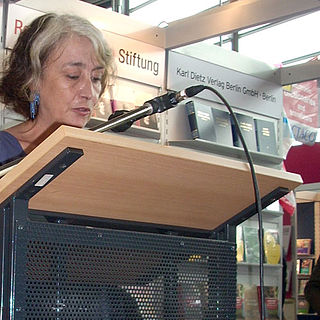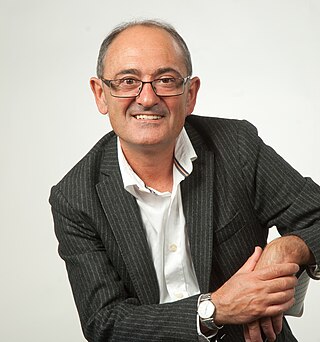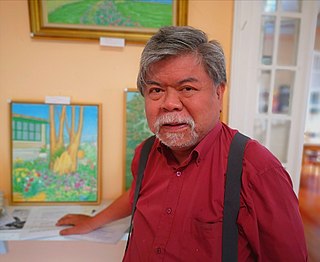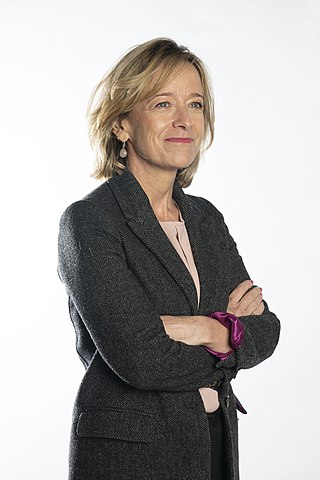Related Research Articles

Mikel Laboa Mancisidor was one of the Basque Country's most important singer-songwriters.
Jesús Mari Lazkano is a Spanish Basque painter. He graduated in fine arts from the University of the Basque Country, where he is Professor of Fine Arts, and has had exhibitions in Europe, America and Asia. Some of his work is part of the Bilbao Guggenheim Museum collection.
Peruvian art has its origin in the Andean civilizations. These civilizations rose in the territory of modern Peru before the arrival of the Spanish.

Arantxa Urretabizkaia Bejarano is a contemporary Basque writer, screenwriter and actress. She was born in Donostia-San Sebastián, Guipúzcoa, País Vasco.
Itziar Okariz is a Basque/Spanish artist based in New York City and San Sebastián.
José Antonio Sistiaga Mosso was a Spanish Basque artist and experimental filmmaker best known for his feature-length hand-painted "direct" film, "Era erera baleibu izik subua aruaren" (1968–70). He lived and worked in the Basque Country, between Ciboure and San Sebastian.

Koldo Zuazo is a Basque linguist, professor at the University of the Basque Country and specialist in Basque language dialectology and sociolinguistics.

Clara Ledesma Terrazas was a Dominican-born American artist

María Luisa Reid is a Mexican artist from Zacatepec in the state of Morelos. She is a member of the Salón de la Plástica Mexicana.

Mirta Toledo is an Argentine artist, that promotes diversity through her artwork.
Abigail Lazkoz is a Spanish artist.
Ana Laura Aláez is a Basque artist. She is one of the most renowned contemporary artists in Spain. She defines herself as an "emotions architect", as she transforms all her life into art, depicting her feelings in her artworks. One of her first exhibitions took place in 1992, in Fundació Joan Miró's Espai 10, in Barcelona. Alberto Peral, another Basque artist, was also featured in this exhibition.
Francisca Sutil is a Chilean artist. She studied at the Southern Methodist University and Pontificia Universidad Católica de Chile and received her M.F.A in printmaking at the Pratt Institute. Her work has been exhibited widely around the world, most recently her work was shown at the Galería Patricia Ready in Chile and the Art Basel Hong Kong. She is also part of various public collections such as the National Gallery of Art in Washington, D.C., and the Museo Nacional de Bellas Artes in Santiago, Chile.

Liliana Maresca was an Argentine artist. Her works cover a variety of styles including sculpture, painting, graphic montages art objects and installations. She was a prominent artist in the period following the dictatorship of the National Reorganization Process. She was a key figure who participated in the artistic scene since the early 80's, starring the enthusiastic young bohemian that detonated Buenos Aires from the early years of democracy rapidly becoming an inflection figure. Her works included objects, installations, performances, interventions in public and semipublic places, and the photographic performances. Maresca died of AIDS in 1994, just a few days after the opening of her retrospective at the Centro Cultural Recoleta in Buenos Aires.
Sonia Gutiérrez is an artist specializing in drawings, oil paintings, and print making. Her artwork is known for focusing on issues and events occurring in Colombia, particularly as a response to the political climate during the 1970s. Because of the political tone she took in her art, she was exiled from Colombia in the mid 1990s.
Marta Palau Bosch was a Spanish-Mexican artist who resided in Mexico. She worked in engraving, painting, sculpture, and most prominently in tapestries, defining herself by her profound artistic use and arrangement of native Mexican natural materials. She was one of the first Mexican artists to focus on themes around women's and immigrants' experiences during the 1970s, especially in her Ilerda series of tapestries and later with her Nahual sculptures.

Mikel Zabalza Garate, also known as Mikel Zabaltza Garate, was a Basque bus driver, and employee of the San Sebastian Municipal Trolley Service. In 1985, he appeared dead in the river Bidasoa. After 35 years of inaction by the Spanish tribunals, it was concluded that Zabalza died as result of torture inflicted on him by Civil Guard operatives at the headquarters of Intxaurrondo in San Sebastián.
June Crespo Oyaga is a Spanish artist.

Antonio "Tony" Diestro Pájaro is a painter from the Philippines. Born in Manila, he studied Fine Arts and then took complementary courses at the University of the Philippines (1970), at the University of Bilbao, ar the University of the Basque Country (1983), and also researched the art and culture of the Philippine tribes Ifugao, Hanunoo, B'Iaan and T'Boli (1988).

Eider Mendoza Larrañaga is a Basque economist and politician affiliated with the Basque National Party. Since 2023, she is the president of the Gipuzkoa Provincial Council, being the first woman to hold the position. She holds a degree in Business Studies and started her political career as a member of the Basque Parliament, from 2001 to 2011. From 2011 to 2019, she was a member of the General Assembly of Gipuzkoa. She was the vice president of the Assembly during the 2011-2015 term. After the Basque National Party's election victory in 2015, she was appointed president (speaker) of the Assembly for the 2015-2019 term. Since 2019 she has been the spokesperson of the Gipuzkoa Provincial Council, and Provincial Deputy of Governance. In 2020, she was named vice-president of Gipuzkoa Provincial Council after a reshuffle by President Markel Olano. She stood for President of the Gipuzkoa Provincial Council in the 2023 foral election.
References
- 1 2 Onandia Garate, Mikel (2013). Artea Durangaldean gaur / Arte en el Duranguesado hoy (in Basque and Spanish). Astarloa Kulturgintza & Ayuntamiento de Durango. p. 82. ISBN 978-84-616-6190-9.
- ↑ "Biography". Artworks Esperanza Zabala. Esperanza Zabala. July 11, 2014. Retrieved March 13, 2015.
- ↑ "Paintings". Artworks Esperanza Zabala. Esperanza Zabala. July 12, 2014. Retrieved March 13, 2015.
- ↑ F.Z., N. (2005). "Ikusi makusi, zer ikusten duzu?" [Esperanza Zabalak azken urteotan egindako margoak batu ditu Beittu Art Galleryn]. Deia (in Basque). Basque Country. Archived from the original on February 7, 2015. Retrieved March 13, 2015.
- ↑ "Esperanza Zabala "Minu nimi on ilu" 13.-- 25. november 2007" (in Estonian). 2007. Retrieved March 13, 2015.
- 1 2 Onandia Garate, Mikel (December 16, 2014). "Okela zelatariak" [Esperanza Zabala]. Berria (in Basque). Basque Country. Retrieved March 13, 2015.
- ↑ "Installations". Artworks Esperanza Zabala. Esperanza Zabala. July 12, 2014. Retrieved March 13, 2015.
- ↑ González, J.M. (2004). "Zelaiko jokalari mutuak" [Esperanza Zabala Artekon]. Mugalari (in Basque) (274). Basque Country. Retrieved March 13, 2015.
- ↑ Marín, Maribel (July 10, 2004). "Una galería presenta tres muestras de vanguardia en paralelo a Manifesta" [Arteko repasa las propuestas de Zabala, Elssie Ansareo y Blami]. El País (in Spanish). Spain. Retrieved March 13, 2015.
- ↑ Morquecho, Félix (December 21, 2014). "Poliuretano, pintura e internet" [Esperanza Zabala presenta una exposición en la sala Topaleku en la que combina su pintura con una instalación]. Diario Vasco (in Spanish). Basque Country. Retrieved March 13, 2015.
- ↑ Irigoien Aizpitarte, Odei (April 9, 2013). "Andrazkoen sormenaren lekuko" [Hamabi autoreren artista liburuak eta beste hainbat obra ikusgai daude Arteko galerian, Donostian]. Berria (in Basque). Basque Country. Retrieved March 13, 2015.
- ↑ E., I. (June 29, 2007). "Ibilbide berria hasi du Beittu arte galeriak". Anboto (in Basque). Basque Country. Archived from the original on February 7, 2015. Retrieved March 13, 2015.
- ↑ Labeaga, Izaskun (June 24, 2007). "La galería Beittu hace balance y apuesta por la edición de obra gráfica". Gara (in Spanish). Basque Country. Archived from the original on February 7, 2015. Retrieved March 13, 2015.